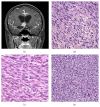A Patient-Derived Xenograft Model of Parameningeal Embryonal Rhabdomyosarcoma for Preclinical Studies
- PMID: 26696773
- PMCID: PMC4677247
- DOI: 10.1155/2015/826124
A Patient-Derived Xenograft Model of Parameningeal Embryonal Rhabdomyosarcoma for Preclinical Studies
Abstract
Embryonal rhabdomyosarcoma (eRMS) is one of the most common soft tissue sarcomas in children and adolescents. Parameningeal eRMS is a variant that is often more difficult to treat than eRMS occurring at other sites. A 14-year-old female with persistent headaches and rapid weight loss was diagnosed with parameningeal eRMS. She progressed and died despite chemotherapy with vincristine, actinomycin-D, and cyclophosphamide plus 50.4 Gy radiation therapy to the primary tumor site. Tumor specimens were acquired by rapid autopsy and tumor tissue was transplanted into immunodeficient mice to create a patient-derived xenograft (PDX) animal model. As autopsy specimens had an ALK R1181C mutation, PDX tumor bearing animals were treated with the pan-kinase inhibitor lestaurtinib but demonstrated no decrease in tumor growth, suggesting that single agent kinase inhibitor therapy may be insufficient in similar cases. This unique parameningeal eRMS PDX model is publicly available for preclinical study.
Figures


References
-
- Shern J. F., Chen L., Chmielecki J., et al. Comprehensive genomic analysis of rhabdomyosarcoma reveals a landscape of alterations affecting a common genetic axis in fusion-positive and fusion-negative tumors. Cancer Discovery. 2014;4(2):216–231. doi: 10.1158/2159-8290.CD-13-0639. - DOI - PMC - PubMed
Grants and funding
LinkOut - more resources
Full Text Sources
Other Literature Sources
Research Materials

